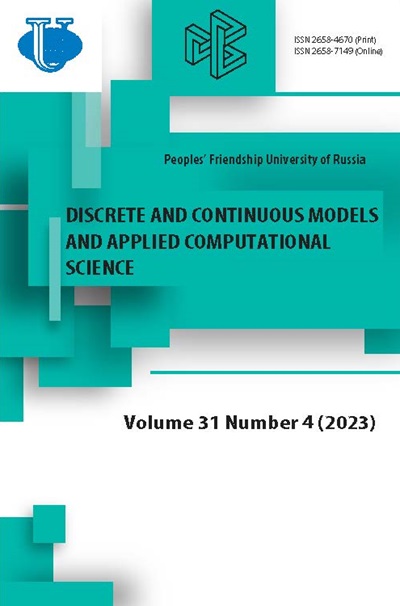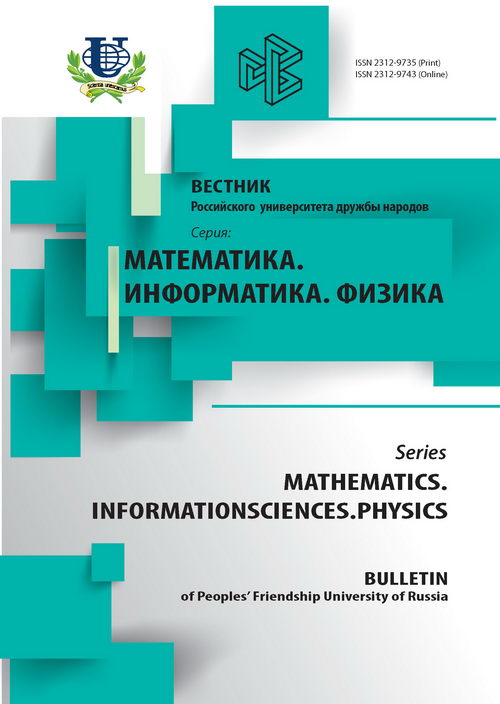№ 4 (2010)
- Год: 2010
- Статей: 18
- URL: https://journals.rudn.ru/miph/issue/view/533
Статьи
 5-10
5-10


О росте решений обыкновенных дифференциальныхуравнений с запаздывающим аргументом
Аннотация
Рассматривается функционально-дифференциальное уравнение -го порядка с неограниченными операторными коэффициентами и отклонениями аргументов в гильбертовом пространстве. Доказывается теорема о существовании решений, убывающих быстрее экспоненты.
Discrete and Continuous Models and Applied Computational Science. 2010;(4):11-25
 11-25
11-25


 26-34
26-34


 35-47
35-47


 48-54
48-54


 55-68
55-68


Построение уравнений Эйлерадля одной задачи минимизации
Аннотация
В статье выводится уравнение Эйлера для сглаживающего функционала, записанного
в нормах пространств Никольского-Бесова, для нахождения приближенного решения
интегрального уравнения первого рода
Discrete and Continuous Models and Applied Computational Science. 2010;(4):69-75
 69-75
69-75


Математическая модель центра обслуживания вы-зовов с двумя типами абонентов
Аннотация
Информационные и справочные службы, страховые компании, а также многие другие организации используют для связи с клиентами центры обслуживания вызовов (ЦОВ). Абоненты компаний могут получить необходимую информацию у оператора или использовать автоматизированное меню. Для качественного обслуживания важных для компании абонентов общий поток всех вызовов может быть разделен на два различных типа по заданному критерию. В статье представлена математическая модель центра обслуживания вызовов с двумя типами абонентов и тремя различными по квалификации группами обслуживающих операторов, получены формулы для расчёта вероятностных характеристик модели. На численном примере исследована эффективность работы системы в
лучае введения дополнительной группы операторов для обслуживания абонентов обоих типов. Результаты работы могут быть применены для анализа функционирования малых ЦОВ с числом операторов до нескольких десятков.
Discrete and Continuous Models and Applied Computational Science. 2010;(4):76-82
 76-82
76-82


Анализ двухканальной системы массового обслуживания ограниченной ёмкости с буфером переупорядочиванияи с распределениями фазового типа
Аннотация
Рассматривается двухканальная система массового обслуживания ограниченной ёмкости с распределениями фазового типа. На выходе из системы имеется буфер, в котором происходит переупорядочивание заявок в соответствии с порядком их поступления. Разработан алгоритм для расчёта стационарных вероятностей состояний данной системы.
Discrete and Continuous Models and Applied Computational Science. 2010;(4):83-87
 83-87
83-87


Анализ свойств решений краевых задач для диф-ференциальных уравнений высоких порядков
Аннотация
Релятивистское обобщение потенциальной модели кваркония приводит к решению спектральной задачи для квазипотенциального уравнения. В частном случае задача сводится к исследованию краевой задачи для обыкновенного дифференциального уравнения конечного порядка с произвольным параметром при старших производных. В работе предложен алгоритм исследования краевых задач для дифференциальных уравнений высоких порядков. Алгоритм реализован с использованием системы символьных вычислений MAPLE. Установлено, что при 0 некоторые решения совпадают с решением нерелятивистского уравнения Шрёдингера. Кроме этого, обнаружены, так называемые погранслойные решения; переход одного типа решения (например, решение с одним узлом) в другой (решение без узлов). Проведены исследования свойств собственных значений и собственных функций при различных значениях.
Discrete and Continuous Models and Applied Computational Science. 2010;(4):88-98
 88-98
88-98


Математическое моделированиенелинейных обобщённо-механических систем в системе компьютерной математики MAPLE
Аннотация
Описаны алгоритмы и комплекс программ для математического моделирования в системах компьютерной математики нелинейных обобщённо-механических систем. Встроенные в пакет программные процедуры позволяют получать численные решения в форме сплайнов, -сплайнов и кусочно-заданных функций. Описаны разработанные программные процедуры операций над сплайнами, позволяющие проводить аналитические вычисления с конвертированными численными решениями как с обычными функциями.
Discrete and Continuous Models and Applied Computational Science. 2010;(4):99-111
 99-111
99-111


Моменты наблюдаемых величин в модели квантовыхизмерений Курышкина-Вудкевича
Аннотация
В рамках конструктивной модели Курышкина Вудкевича теории квантовых измерений рассмотрена проблема вычисления измеренных моментов наблюдаемых величин. Данная проблема связана с проблемой вычисления дисперсии измеренных значений наблюдаемой, подробно рассмотренной в работах В. Курышкина. Значения моментов и дисперсии однозначно определяются квантовой функцией распределения Курышкина-Вудкевича.
Discrete and Continuous Models and Applied Computational Science. 2010;(4):112-117
 112-117
112-117


Реализации эвристики коллективного поведения в квантовой динамике многих тел
Аннотация
В статье показаны пути построения алгоритмов моделирования динамики систем многих тел на основе эвристики коллективного поведения, включающие метод Фейнмана интегралов по путям, метод Бома и метод динамического диффузионного роя. Обсуждаются достоинства и недостатки этих методов.
Discrete and Continuous Models and Applied Computational Science. 2010;(4):118-120
 118-120
118-120


Эффекты жёсткого воздействия полейтёмного сектора на космологические возмущения
Аннотация
В статье рассмотрено развитие полей тёмного сектора на основе динамических уравнений на фоне инфляционной стадии эволюции Вселенной. При этом считается, что энергетические характеристики полей тёмного сектора того же порядка, что и возмущения гравитационного поля и инфлатона. Исследованы эффекты воздействия полей
тёмного сектора на формирование крупномасштабной структуры на примере экспоненциальной инфляции.
Discrete and Continuous Models and Applied Computational Science. 2010;(4):121-132
 121-132
121-132


 133-135
133-135


Вакуумное рождение частиц скалярного поля в конформно-инвариантной теории гравитации. Гамильтонов формализм и квантование релятивистских систем
Аннотация
В настоящей работе рассмотрена модель вакуумного рождения скалярных частиц в конформно-инвариантной модели гравитации в рамках гамильтонова (дираковского) подхода. Построены в явном виде уравнения, задающие в том числе зависимость наблюдаемой плотности числа частиц скалярного поля от начальных данных и инвариантного параметра эволюции.
Рассмотрены проблемы объединения принципов общей теории относительности (ОТО) и квантовой теории поля (КТП) на простом примере вакуумного рождения скалярных частиц в конформно-инвариантной модели гравитации. Показано, что такая модель может описать как возможный механизм такого рождения, так и способы его обобщения на более сложные модели, в том числе и на Стандартную Модель (СМ).
Сформулирован некоторый новый подход к квантованию релятивистских гравитирующих систем, суть которого заключается в квантовании фазового пространства начальных данных как интегралов движения системы, полученных путём Боголюбовской диагонализации уравнений гамильтонова формализма, и в доказательстве эквивалентности
такого квантования переходу от классических пространственно-временных переменных к их некоммутирующим квантовым аналогам Вышеописанная схема может быть применена для исходного многообразия любой конечной мерности и топологии.
Discrete and Continuous Models and Applied Computational Science. 2010;(4):136-144
 136-144
136-144


Наши авторы
Discrete and Continuous Models and Applied Computational Science. 2010;(4):145-146
 145-146
145-146


Правила оформлениястатей
Discrete and Continuous Models and Applied Computational Science. 2010;(4):147-147
 147-147
147-147
















